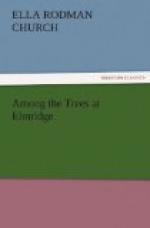“’The kernels, or seeds, from the cones of the stone-pine have always been esteemed as a delicacy. In the old days of Rome and Greece they were preserved in honey, and some of the larders of the ill-fated city of Pompeii were amply stored with jars of this agreeable conserve, which were found intact after all those years. The kernels are also sugared over and used as bonbons. They enter into many dishes of Italian cookery, but great care has to be taken not to expose them to the air. They are usually kept in the cones until they are wanted, and will then retain their freshness for some years. The squirrels eagerly seek after the fruit of this pine and almost subsist upon it. They take the cone in their paws and dash out the seeds, thus scattering many of them and helping to propagate the tree.
“’There is a bird called the crossbill that makes its nest in the pine. It fixes its nest in place by means of the resin of the tree and coats it with the same material, so as to render it impervious to the rain. The seeds from the cones form its chief food, and it extracts them with its curious bill, the two parts of which cross each other. It grasps the cone with its foot, after the fashion of a parrot, and digs into it with the upper part of its bill, which is like a hook, and forces out the seed with a jerk.’”
[Illustration: PINE-CONE (Pinus Sylvestris.)]
The children enjoyed this account very much, and they thought that stone-pine nuts—which they had never seen, and perhaps never would see—must be the most delicious nuts that ever grew.
“What nice times the birds have,” said Clara, “helping themselves to all the good things that other people can’t reach!”
“They are not exactly ‘people,’” replied Miss Harson, laughing; “and, in spite of all these ‘nice times,’ you would not be quite willing to change with them, I think.”
No, on the whole, Clara was quite sure that she would not.
CHAPTER XX.
MORE WINTER TREES: THE FIRS AND THE SPRUCES.
There were some beautiful evergreens on the lawn at Elmridge, and, although the foliage seemed dark in summer, it gave the place a very cheerful look in winter, when other trees were quite bare, while the birds flew in and out of them so constantly that spring seemed to have come long before it really did arrive.
“This balsam-fir,” said Miss Harson as they stood near a tall, beautiful tree that tapered to a point, “has, you see, a straight, smooth trunk and tapers regularly and rapidly to the top. You will notice, too, that the leaves, which are needle-shaped and nearly flat, do not grow in clusters, but singly, and that their color is peculiar. There are faint white lines on the upper part and a silvery-blue tinge beneath, and this silvery look is produced by many lines of small, shining resinous dots. The deep-green bark, striped with gray, is full of balsam, or resin,




